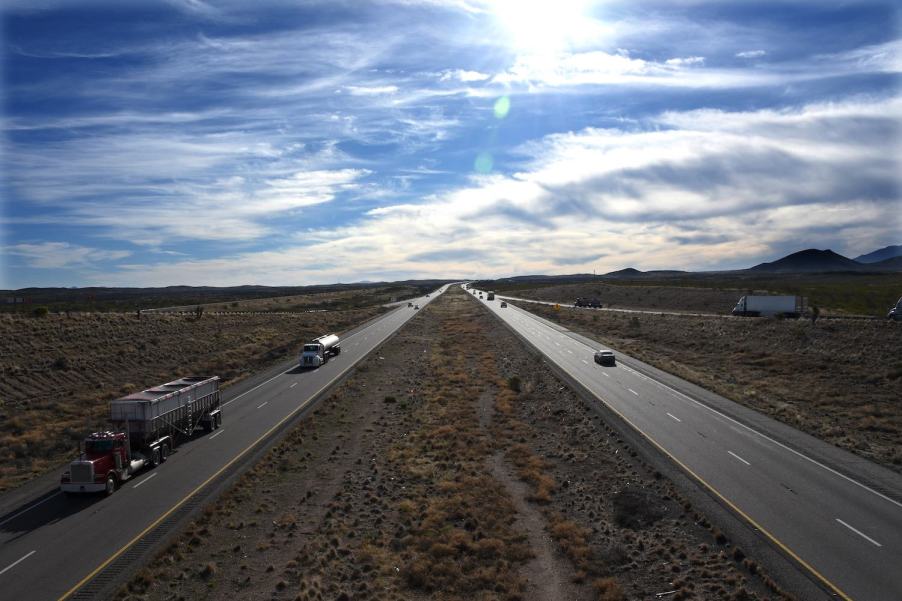
Only 1 Major ‘Interstate’ Highway Begins and Ends in the Same State
The system of “major” interstate highways is the USA’s original grid of divided roads with two-number names that end in “0” or “5”. (Not to be confused with the “minor” local highways, which fill out the grid and end in other numbers. And not to be confused with the “spurs” and “byways” which have three-digit names). Only one interstate “major” from this original grid still begins and ends in one state: I-45, which connects Dallas, and Houston, Texas. You may be thinking, “What about Alaska and Hawaii!?” These standalone states are not part of the “Interstate” highway system, but instead have special divided roads with names that begin in “AL” or “H” instead of “I.” Texas is actually home to multiple unique roads, such as a byway with the fastest posted speed limit in the USA: the “Pickle Parkway.”
When did Interstate 45 open?
Technically, a section of Interstate Highway 45 south of Houston, Texas first opened for business in 1948. It was not renamed I-45 until President Dwight Eisenhower’s system of the original “major” divided interstate highways was planned out. The full interstate went into use in 1971.

The stretch of I-45 that runs from Houston down to Galveston is often called the “Gulf Freeway” by Houston residents. But it is technically still I-45. So this highway not only connects Dallas and Houston, but it stretches to Galveston as well.
The original Eisenhower Highway System grid is subject to strict naming conventions. Like the other highways that end in a “5,” Interstate 45 runs north-south. In addition, it falls between Interstate 35 (to its west) and Interstate 55. Interstate 55 runs from Chicago to LaPlace, Louisiana and steers well clear of I-45. But Interstate 35 begins in Duluth, Minnesota, and runs south to Laredo, Texas. Both I-35 and I-45 run through the greater Dallas area.
Is Interstate 45 a highway or a spur?
I-45 and I-35 never physically touch in downtown Dallas, so Interstate 45 is not technically a spur. This is one of two reasons the 284-mile road is its own major interstate highway.

In Dallas, the northern terminus of I-45 tees into I-30 (which runs east-west). Also, in Dallas, I-35 splits into I-35E (which runs through downtown) and I-35W (circumventing Dallas to serve the Ft. Worth metro area). I-35E crosses I-30 just 1.5 miles west of the northern terminus of I-45. So close, but not a spur!
One reason I-45 may have received full “major” interstate highway status may be that its engineers planned to continue it further north eventually. Another reason may have been that the original grid of major highways had an opening between I-35 and I-55. That said, the east-west highways already have a gap.
Where is this gap? Take a careful look at the map above: I-70 runs east-west from Baltimore, Maryland, to Cove Fort, Utah. Below that, I-40 runs from Barstow, California, to Little Rock, Arkansas, where it tees into I-30. So why is there no I-50 or I-60? The highway designers worried these roads would get mixed up with the then-popular “U.S. Route” system (such as the famous Route 66). Because the Routes are named in descending order and the Highways named in ascending order, the roads closer to the edges of the country are safe from confusion.
Texas is also home to the Pickle Parkway: America’s fastest road
I-45 may be unique because it is the USA’s only major original interstate highway contained in one state. But it is far from the only exceptional highway in Texas.
Texas State Highway 130 is a privately built toll road between San Antonio and Georgetown, allowing drivers to circumvent Austin traffic on I-35. At 85 MPH, its posted speed limit is one of the highest in the world–only three roads have higher posted limits! Another interesting thing about 130 is that it is named after Congressman J.J. “Jake” Pickle and is called the Pickle Parkway.Next, read all about the Pickle Parkway and even faster highways, or learn more about the original major Interstate Highway System’s naming convention in the video below:






